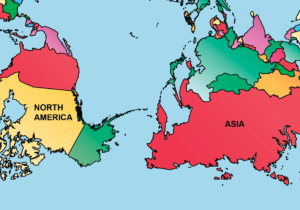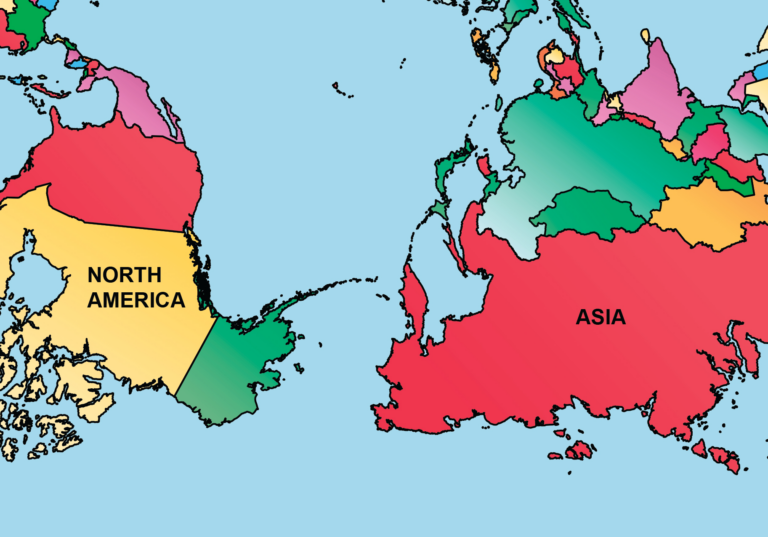Experienced world travelers and global observers get it: we live in an Asia-centered world. “If you want to understand the world,” says the Pulitzer Prize-winning New York Times journalist Nicholas D. Kristof, “you need to understand Asia.”1
Historians and archaeologists point out that this has been the case, more often than not, throughout the human experience. Despite the world domination achieved by North Atlantic societies over the past few centuries, what many glibly call “the rise of China” and other Asian powers actually is a return to historic global norms. “The most people, production, and wealth over most of the world’s history are in the East,” wrote Albert Bergesen almost twenty years ago.2 But because many of us see the world in terms of only the recent past or of our own cultural and geographical location, the picture of an Asia-centered world can appear to be upside down.
The National Intelligence Council now predicts that China’s economy, which anchors the East Asian geopolitical region, will surpass that of the United States before 2030.3 Assistant Secretary of State for East Asian and Pacific Affairs Kurt Campbell recently remarked that “it is very hard [for the United States] to operate effectively – diplomatically, politically or strategically – in Asia without a strong relationship with Japan.”4 This is the world that Berea College graduates will inherit, and it is the world that Berea’s Asian Studies Program seeks to help them understand.
The second of Berea’s “Great Commitments” charges our institution with providing “an education of high quality with a liberal arts foundation and outlook.” Much ink has been spilled in efforts to define precisely what is meant by both “quality” and “liberal arts” in terms of college-level teaching and learning, but most of us who are involved in higher education probably would agree that both of these entail development of students’ ability to see their concerns in global context, communicate and advocate for their concerns clearly and persuasively, and engage in the work of building a more free, just, and equitable world.5 The Asian Studies Program offers courses in the anthropology, art, history, languages, politics, and religions of the region that is home to approximately two out of three human beings alive today. This work is a response to the charge given by President Francis S. Hutchins in his 1939 inaugural address:
Anyone who has roamed from his home country will have noticed the constant intermingling of ideas, culture, and goods from one nation to another…. Our curriculum must always be those cultural objects which will enable us to think, and understand the world in which we live.6
President Hutchins, who came to Berea after spending nearly twenty years in China, was well aware of how important an informed understanding of Asia was for Americans, and during his time at Berea, he did all that he could to bring Asia to Appalachia. Like other Bereans, he wanted to make the gift of global knowledge available not only to the wealthy and the privileged, but also to the young men and women from socioeconomically distressed backgrounds who study here. Since 2001, when the first independent majors in Asian Studies (which was granted official status as a major in 2007) graduated from Berea, 61 students with majors or minors in Asian Studies have completed their degrees. More than 300 Bereans from all disciplinary backgrounds have studied abroad in Asia; more than two dozen will spend all or part of the 2014-15 academic year in Asia. The education for an Asia-centered world that our graduates receive here in Appalachia has enabled 36% of them to find employment in Asia or in Asia-related fields.
Even those who acknowledge the global economic and political importance of Asia may wonder why it is worthwhile to study Asian cultures. After all, we live in a world in which English is widely spoken, Western concepts of democracy and human rights are widely embraced, and faiths such as Christianity and Islam are widely practiced. In such a world, why do we need to learn Chinese, comprehend why organ donation is more controversial than abortion in Japan, or understand Buddhist sculpture?
The answer lies in Berea College’s responsibility “to assert the kinship of all people and to provide interracial education,” as described by the fifth “Great Commitment.” Asian and non-Asian traditions converge in agreement on the unity of the human experience across the diversity of cultures, ethnicities, and races. Two centuries before the ancient Roman comedian Publius Terentius Afer (195-159 BCE) proclaimed, “I am human – nothing human is alien to me,” the ancient Chinese sage Confucius (551-479 BCE) observed that “By nature, human beings are pretty much alike – it is learning and practice that set them apart.” These two threads in “the great civilized conversation” (as the distinguished scholar of East Asian philosophy and religion, Wm. Theodore de Bary, titled his 2013 book on how liberal arts education must become cross-cultural in scope) also intertwine around the question of the deep interconnectedness of all peoples and all learning. Writing in the midst of China’s Tang dynasty – a global high point for cosmopolitanism and intercultural exchange – the Buddhist commentator Fazang (643-712 CE) mused that “the nature of things lies in multiple relationships reflecting each other unendingly in all things.” More than a millennium later, the American conservationist John Muir (1838-1914 CE) pointed out that “when we try to pick out anything by itself, we find it hitched to everything else in the universe.” When students realize that human concerns such as beauty, goodness, and justice are not the exclusive property of one culture, but are engaged in a multitude of ways by all human beings in all times and places, they take a critical step toward acknowledging and appreciating their kinship with all people – a kinship that bridges interracial gaps as well as other obstacles to mutual understanding, sympathy, and cooperation. Teaching and learning in Asian Studies, which entails consideration of the world’s oldest continuous traditions of artistic, literary, philosophical, and religious reflection on the human experience, is vital to the fulfillment of this fifth great responsibility of the College.
Despite the many contributions of Asian Studies to the liberal education and global worldview facilitated by the Berea experience, there may yet be those who question the place of Asia in an Appalachian institution that primarily serves students from Appalachian backgrounds. “What has Athens to do with Jerusalem?” cried the early Christian thinker, Tertullian, who was hostile to any learning beyond that which Christian scriptures could provide. One might well ask, “What has Asia to do with Appalachia?” Although it may not be obvious, the appropriate reply to this query is, “More than you may realize.”

As of 2013, Americans of Asian descent make up the fastest-growing ethnic group in the United States.7 In fact, those of Asian descent are among the few people who are moving into Appalachia, as opposed to moving out of the region.8 While no more than 6.5% of the population in any southern Appalachian state identifies as Asian-American, the fact is that factors other than sheer numbers amplify the impact of Asian-Americans on American life, including life in Appalachia.9 Given that Asian-Americans possess, on average, more education and personal wealth than other Americans, it may well be that these are among the most likely Appalachians to speed the region’s economic recovery and development.10 Asian-Americans are more likely than members of any other ethnic group in the United States to marry across ethnic lines, with almost 40% of all Asian-American women marrying men who are not of Asian descent.11 Berea is no stranger to the children and grandchildren of these marriages, many of whom wear an Asian face but speak with an Appalachian accent. By mingling with other Americans in Appalachia’s churches, communities, and schools, these “Appalasians” help to remind their fellow worshippers, neighbors, and classmates of the many ways in which Asia is present in the lives of all Appalachians.
Even if most Appalachians are not of Asian descent, many Appalachians are employed by Asian-owned businesses. In 2012, almost 35 percent of all capital investment and approximately one out of five new manufacturing, service, and technology jobs created in Kentucky were the result of such companies. Today, Japanese-owned firms alone employ more than 38,000 Kentuckians.12 Moreover, Appalachia’s economic exchange with Asia travels in more than one direction. In September 2013, a delegation of 18 Appalachian furniture and wood product manufacturers secured more than $50 million in new sales to Asian clients after participating in an international trade show in Shanghai, China.13 The persistent enthusiasm of Berea students for learning about Asia, especially Japan, probably has something to do with the continuing contributions of Asian enterprises to Appalachian economies.
Ultimately, the question of what Asia has to do with Appalachia comes down to whether students in Appalachia – both those who claim the region as their home and those who come here to learn – deserve the same broadly global educational opportunities that their wealthier counterparts outside of the region take for granted. The Asian Studies Program believes that they do. Indeed, we have found that Bereans seize every available opportunity to acquire fluency in Asian languages, become conversant with Asian art, history, and thought, and immerse themselves in Asian societies as exchange students and interns. Not only the dozens of Berea graduates who have majored or minored in Asian Studies, but also the hundreds of Berea graduates who have completed Asia-focused courses that met General Education requirements, have expressed their gratitude for an education that included the study of Asian cultures – which, despite representing approximately two out of every three human beings alive today, remain relatively unfamiliar to many of our students and most Americans.
1 “Where to Go to Understand the World in 2012,” New York Times, January 6, 2012, http://tinyurl.com/ny6qc4q.
2 “Let’s Be Frank About World History,” in Civilizations and World-Systems: Studying World-Historical Change, ed. Stephen K. Sanderson (Walnut Creek, CA: AltaMira Press, 1995), 202.
3 Charles Riley, “Intel report: China’s economy to surpass U.S. by 2030,” CNN Money, http://economy.money.cnn.com/2012/12/10/china-us-economy/.
4 Peter Ennis, “Why Japan Still Matters,” Brookings Institution, http://www.brookings.edu/research/papers/2011/05/10-japan-ennis.
5 See “What Is A 21st Century Liberal Education?,” American Association of Colleges and Universities, https://www.aacu.org/leap/what_is_liberal_education.cfm
6 “Full Text of Chimes, 1940,” Internet Archive, http://archive.org/stream/chimes194012bere/chimes194012bere_djvu.txt.
7 “The Rise of Asian Americans,” Pew Research, http://www.pewsocialtrends.org/2012/06/19/the-rise-of-asian-americans/.
8 Kelvin M. Pollard, “‘A New Diversity’: Race and Ethnicity in the Appalachian Region,” Population Reference Bureau, http://www.prb.org/pdf04/anewdiversityappal.pdf.
9 “Total U.S. Asian American Population,” Pew Research, http://www.pewsocialtrends.org/asianamericans-maps/.
10 “The Rise of Asian Americans,” Pew Research, http://www.pewsocialtrends.org/2012/06/19/the-rise-of-asian-americans/.
11 Ibid.
12 “Kentucky Names New Economic Development Representative in Asia,” Kentucky Cabinet for Economic Development, http://www.thinkkentucky.com/newsroom/NewsPage.aspx?x=08222013_newjprep.html.
13 Earl F. Gohl, “Made in Rural America: Helping Appalachian Business Sell to the World,” The White House, http://www.whitehouse.gov/blog/2014/02/18/made-rural-america-helping-appalachian-business-sell-world.



This general mindset is very ignorant and ill-informed. Frame this in a way that doesn’t enforce and normalize the model minority myth, or don’t share at all. As an Asian American Appalachian, no one of this identity uses the term “Appalasian”, and the erasure of the many Asian Americans in Appalachia is very offensive but not surprising. Asian Americans in Appalachia are among the most marginalized and economically unsound. Delve into the impact of the Vietnam War, Korean War, and US colonization of the Philippines, and how those events have devestated both Appalachia and Asia, as well as heavily impacted… Read more »
Aelin,
Thank you for your honest feedback. This article was published in 2015, which means it’s seven years out of date and it also pre-dates my tenure as editor. I think you make a lot of great points, and if you were ever interested in writing an article for the Berea College Magazine that shared a better perspective, I would welcome such a piece.
-Abbie Darst ’03
Director of Publications and Media Relations